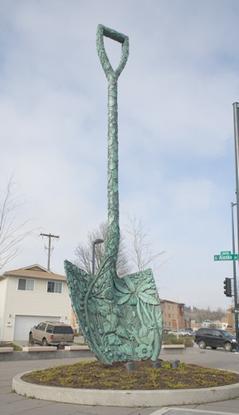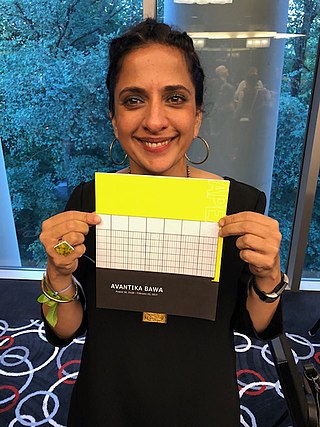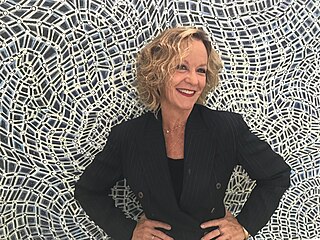
The Walker Art Center is a multidisciplinary contemporary art center in the Lowry Hill neighborhood of Minneapolis, Minnesota, United States. The Walker is one of the most-visited modern and contemporary art museums in the U.S.: together with the adjacent Minneapolis Sculpture Garden and the Cowles Conservatory, it has an annual attendance of around 700,000 visitors. The museum's permanent collection includes over 13,000 modern and contemporary art pieces, including books, costumes, drawings, media works, paintings, photography, prints, and sculpture.

The Museum of Contemporary Art (MCA) Chicago is a contemporary art museum near Water Tower Place in downtown Chicago in Cook County, Illinois, United States. The museum, which was established in 1967, is one of the world's largest contemporary art venues. The museum's collection is composed of thousands of objects of Post-World War II visual art. The museum is run gallery-style, with individually curated exhibitions throughout the year. Each exhibition may be composed of temporary loans, pieces from their permanent collection, or a combination of the two.

Barnsdall Art Park is a city park located in the East Hollywood district of Los Angeles, California. Parking and arts buildings access is from Hollywood Boulevard on the north side of the park. The park is a Los Angeles Historic-Cultural Monument, and a facility of the City of Los Angeles Department of Cultural Affairs.

The Nancy Cantor Warehouse, or simply The Warehouse, is a former storage warehouse of the Syracuse-based Dunk and Bright Furniture Company in Downtown Syracuse, New York, United States. It is owned and utilized by Syracuse University.

Peter Halley is an American artist and a central figure in the Neo-Conceptualist movement of the 1980s. Known for his Day-Glo geometric paintings, Halley is also a writer, the former publisher of index Magazine, and a teacher; he served as director of graduate studies in painting and printmaking at the Yale University School of Art from 2002 to 2011. Halley lives and works in New York City.

The Renaissance Society, founded in 1915, is a leading independent contemporary art museum located on the campus of the University of Chicago, with a focus on the commissioning and production of new works by international artists. The kunsthalle-style institution typically presents four exhibitions each year, along with concerts, performances, screenings, readings, and lectures—all of which are free and open to the public. "The Ren" also produces publications in conjunction with many of its exhibitions.

Arts Club of Chicago is a private club and public exhibition space located in the Near North Side community area of Chicago, a block east of the Magnificent Mile, that exhibits international contemporary art. It was founded in 1916, inspired by the success of the Art Institute of Chicago's handling of the Armory Show. Its founding was viewed as a statement that art had become an important component of civilized urban life. The Arts Club is said to have been pro-Modernist from its founding. The Club strove to break new ground with its shows, rather than collect the works of established artists as the Art Institute does.

Kristin Jones and Andrew Ginzel are a contemporary American artist team. Both Jones and Ginzel pursue independent careers in the arts, but they are best known for their collaborative, large scale public art projects, installations and exhibitions in museums and galleries internationally.

Boeing Galleries are a pair of outdoor exhibition spaces within Millennium Park in the Loop community area of Chicago in Cook County, Illinois, United States. The spaces are located along the south and north mid-level terraces, above and east of Wrigley Square and the Crown Fountain. In a conference at the Chicago Cultural Center, Boeing President and Chief Executive Officer James Bell to Chicago Mayor Richard M. Daley announced Boeing would make a $5 million grant to fund both the construction of and an endowment for the space.

The Los Angeles Municipal Art Gallery is located in the Barnsdall Art Park in Los Angeles, California. It focuses on the arts and artists of Southern California. The gallery was first established in 1954.

Victoria Barrett Fuller is an American artist, sculptor, natural science illustrator, and award-winning singer, songwriter, and musician.
Jennifer Vanderpool is an American artist living and working in Los Angeles. In her work "there is a chipper cynicism to the retro character of the figures, buildings, fashions, and patterns, so that there is certainly a sense of tradition, yet there is also a sense of transference and surrealism."
Lisa Wainwright is an American art historian at the School of the Art Institute of Chicago. She previously served SAIC as the Dean of Faculty and Vice President of Academic Affairs, as well as Title IX officer for faculty. Wainwright received a Ph.D. in the history of 19th and 20th-century art, University of Illinois, 1993; an M.A. in history of 19th and 20th-century art, University of Illinois, December 1986, and a B.A. cum laude, Vanderbilt University, art history, June 1982. She also studied at the Goethe-Institut in Blaubeuren, Germany, in summer 1982.
Annette Louise Barbier was an American artist and educator. She worked with video art, net art, installation art, interactive performance, and emerging and experimental technologies since the 1970s. Themes in her work address "issues of home, defined locally as domesticity and more broadly as the ways in which we relate to our environment." An early work, "Home Invasion [1995]," incorporating critical dialogue and audio, is accessible from Leonardo. "Domestic space—formerly inviolable—is increasingly disrupted by electronic communication of all sorts, including radio, TV, email and the telephone." She was Chicago-based.

Avantika Bawa is an Indian American artist, curator, and professor of art. Bawa is a multidisciplinary artist who works primarily in site-specific installation, video, printmaking, and drawing. She is the recipient of the 2018 Crow's Shadow Institute of the Arts Golden Spot Residency Award, the Hallie Ford Fellowship in the Visual Arts, and the Oregon Arts Commission Joan Shipley Award.
Barbara Sykes into a family of artists, designers and inventors. Since childhood, she has produced work in a variety of different art forms. In 1974, she became one of Chicago's pioneering video and new media artists and, later to include, independent video producer, exhibition curator and teacher. Sykes is a Chicago based experimental video artist who explores themes of spirituality, ritual and indigeneity from a feminist perspective. Sykes is known for her pioneering experimentation with computer graphics in her video work, utilizing the Electronic Visualization Laboratory at the University of Illinois, Chicago, at a time when this technology was just emerging. Her early works broke new grounds in Chicago's emerging New Media Art scene, and continue to inspire women to explore experimental realms. With a passion for community, she fostered significant collaborations with many institutions that include but are not limited to University of Illinois, School of the Art Institute of Chicago, Columbia College, Center for New Television, and (art)n laboratory. These collaborations became exemplary for the showcasing of new media work. The wave of video, new media and computer art that she pioneered alongside many other seminal early Chicago New Media artists persists as a major influence for artists and educators today. Her work has been exhibited internationally, at institutions such as Moderna Museet (Stockholm), Ny Carlsberg Glyptotek (Copenhagen), Musée d'Art Moderne de la Ville de Paris, Museum of Contemporary Art San Diego, Metropolitan Museum of Art , Museum of the Art Institute (Chicago), The Metropolitan Museum of Art and SIGGRAPH. Sykes's tapes have been broadcast in Sweden, Italy, Puerto Rico and extensively throughout in the US, including "The Independents", PBS national broadcast, 1985, and national cablecast, 1984. Media Burn has an online selection of her tapes and over 200 of her raw footage, master edits, dubs and compilation tapes in their Independent Video Archives @ Barbara Sykes https://mediaburn.org/collections/videomakers-page/barbara-sykes/. Select grants include a National Endowment for the Arts and American Film Institute Regional Fellowship, Evanston Art Council Cultural Arts Fund and several Illinois Arts Council grants. In 2017, Sykes began to paint. In 2020, as the recipient of an Evanston Art Center Individual Artist Exhibition Award, Ethereal Abstractions, Sykes's first solo watercolor exhibition premiered 81paintings and she gave an online Artist Talk. Her paintings are lyrical, colorful abstractions reminiscent of organic shapes, ethereal forms and underwater landscapes - evocative impressions of spiritual and elemental worlds. They evoke the spontaneity and themes that have evolved from her previous body of time-based and digital artwork. In 2021, she moved to Florida. Her 2022 painting exhibitions/reviews include Forces of Nature showcased on the cover of Estero Life Magazine and she is in the article, Beholding Beauty: Artists of Estero Exhibit at COCO Art Gallery, the Florida Watercolor Society's 2022 Online Show, the 36th Annual All Florida Exhibition and Connections Art in Flight exhibit at the Southwest Florida International Airport, June 2022 to June 2023. She paints under the name of Barbara L. Sykes.
Torkwase Dyson is an interdisciplinary artist based in Beacon, New York, United States. Dyson describes the themes of her work as "architecture, infrastructure, environmental justice, and abstract drawing." Her work is informed by her own theory of Black Compositional Thought. This working term considers how spatial networks—paths, throughways, water, architecture, and geographies—are composed by Black bodies as a means of exploring potential networks for Black liberation. She is represented by Pace Gallery and Richard Gray Gallery.
Amanda Williams is a visual artist based in Bridgeport, Chicago. Williams grew up in Chicago's South Side and trained as an architect. Her work investigates color, race, and space while blurring the conventional line between art and architecture. She has taught at the California College of the Arts in San Francisco, Sam Fox School of Design & Visual Arts at Washington University in St. Louis, Illinois Institute of Technology, and her alma mater Cornell University. Williams has lectured and at the Metropolitan Museum of Art, New Museum, School of the Art Institute of Chicago, and at a TED conference.

Rodney Carswell is an American abstract artist. He first gained recognition for human-scaled, geometric paintings that feature exposed, projected support structures, creating interplay between sculptural presence and richly painted pictorial surfaces. His recent paintings eschew the superstructures and evoke a greater sense of immediacy, playfulness, and narrative. Critics often describe Carswell's work as uncanny, elusive or quirky, for its tendency to negotiate "in-between" spaces and embrace contradictions such as order and instability, intention and accident, or back and front. Employing irregularly shaped canvasses, thick supports, and openings or holes that reveal the stretcher construction and walls behind them, works like 3 (1994) often occupy a place between painting and sculpture. In a similar way, Carswell uses the modernist languages of Minimalism, Suprematism and Constructivism, yet eludes those categories with postmodern allusions to architecture, the body and spiritual iconography, and with his process-oriented, "hand-made" surfaces. In his essay for Carswell's mid-career retrospective at Chicago's Renaissance Society, Los Angeles Times critic David Pagel suggested that his understated paintings worked their way into one's consciousness in a "supple, somewhat unsettling manner" that achieves a subtle, but lingering shift in perception.

Susan Sensemann is an American artist, educator and arts administrator, best known for her detailed, largely abstract patterned paintings and photomontages reflecting gothic, baroque, spiritual and feminist sensibilities. She has exhibited her work at venues including the Art Institute of Chicago, A.I.R., The Living Art Museum (Reykjavík), Indianapolis Art Center, Chicago Cultural Center, and Art Institute of Boston, on four continents. Her work has been widely reviewed and resides in numerous private, university and corporate collections. Sensemann is known as a versatile and prolific creator, whose ideas have led her to explore diverse painting materials, media, subject matter, and styles from abstraction to realism. Critics note her work's densely packed compositions, shallow fields of oscillating space, complex tactile surfaces, and sensuous color and linearity. James Yood wrote that Sensemann's abstract paintings were "fraught with meaning, charged with value, and seething with import" in their spiritual seeking. Art historian Leisa Rundquist described her photomontage self-portraits as "strangely sensual, yet disturbing" images drawn from "the depths of the unconscious."














